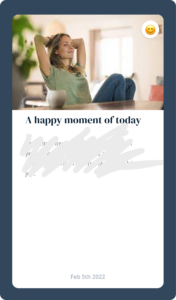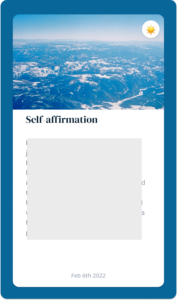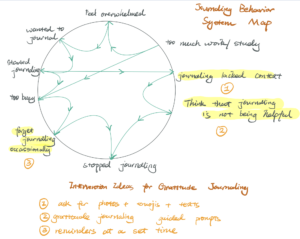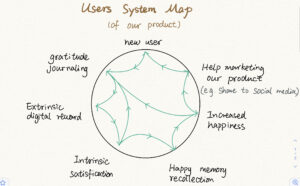Intervention Study
Time
From Feb 2 Wednesday to Feb 6 Sunday
Number of participants
8 (four of the participants also participated in our baseline study)
Design of the study
Premises
- Gratitude journaling has been proven to relieve stress and increase happiness effectively.
- Intrinsic rewards are better motivations for behavior than extrinsic rewards.
- We can use a rewarding system to help people develop a habit.
Data Collection Method
We sent participants emails every night at 9 PM reminding them to fill out the gratitude journaling google form. We compiled a list of gratitude journaling prompts (gratitude letter, a happy moment of today, self-affirmation, a small beauty I discovered today). We asked them to select one to respond to every day. We also request a photo and an emoji for the written content. On day five (the final day), we added two questions asking participants their opinions about the study.

Rewarding system
We designed a rewarding mechanism that uses external rewards to incentivize people to start to do gratitude journaling and eventually internalize the joy and form a habit of doing so. Our ultimate goal is to have people feel intrinsic satisfaction. The participants receive rewards daily as a designed digital card containing their written journal, selected emoji and uploaded a photo from the previous day’s response. To create a sense of uncertainty in our rewards, the style of the digital cards changes every day based on the uploaded photo. We hoped that this would make our participants look forward to seeing the card and therefore writing a journal entry.


Key Findings and Results
- Four out of the eight participants finished the study. Among those who wrote a journal entry on day five, all of them but one think that the study changed their attitude towards journaling in a positive way.
- Compared to baseline studies, we have more comments in the feedback section at the end of the daily data collection form which is an indication of higher engagement rate from participants
- Our participants like the idea of digital cards as rewards and the visual appeal of having a collection of cards.
- One of the participants likes the “silent listener” part when writing down journals in our study.
Visualized models
We created two system maps for the idea. The first one depicts struggles and crises of the journaling behavior, while the second describes how the users of our product can form a positive feedback loop and successfully build a habit of gratitude journaling.


Highlighted Feedbacks from Participants
- I feel like, by filling out the form, I am answering questions and the style of writing doesn’t feel like diary-writing. (It may just be my opinion)
- One emoji isn’t enough lol
- Finding it a bit difficult to select only one moment of joy – especially if there’s nothing particularly joyful that stood out. Perhaps wording it as moment(s) of joy helps
- Didn’t know what to do when I had an extremely bad day
- One of our participants loves the “social” aspect of it. Since she knew that we will be making journal cards and may read the content, “When I know someone is receiving my daily journal entry, however, I write with another person in mind, not in the way of telling a story or performing, but as if I am talking to a friend, who is (perhaps only absent-mindedly) listening to me talk about the day. The knowledge of a present, albeit silent, listener/community has been interesting. Evidently, this presence means some topics/observations that would appear in my actual journal are inappropriate, but this presence has been a surprisingly warming one, as if I am in a one-way friendship.”
- “Collecting only 1 or 2 (digital cards) doesn’t seem that appealing, but having a bunch all together is very satisfying to the eyes.”
- I think this reminded me that there are indeed many nice small moments in everyday life and they are worth being recorded.
- I am slightly surprised by how there’s almost something worth writing about every day. Perhaps not extremely worth writing about, but a short blurb is a good way to document.
- Seeing it being made into beautiful cards actually made me realize that it is important for us to save important/happy moments in my life. These cards helped me recognize the beauty of these moments.
Ideas for designing final solution
- We realized that we forgot to explain the motivation and benefits of gratitude journaling to our participants beforehand. Since it would be difficult to switch to a new routine without knowing the benefits of it, we will need to incorporate such content or instruction into our final product.
- We can include the same rewarding mechanism into our final product, where the cards will be automatically generated. We are thinking about creating different themes or sets of cards.
- We can incorporate an empathetic design similar to the “silent listener” into our product (perhaps social features is an alternative to this).



